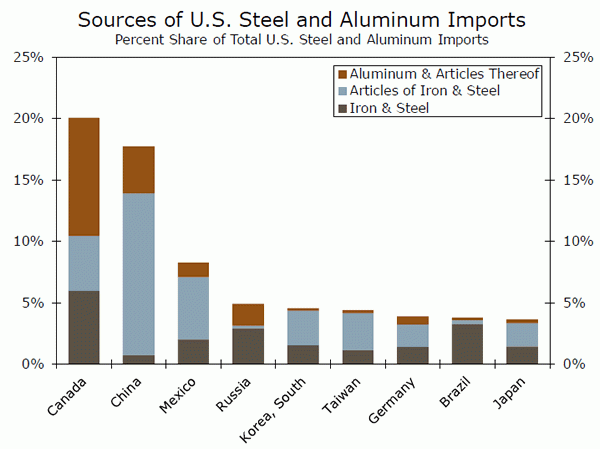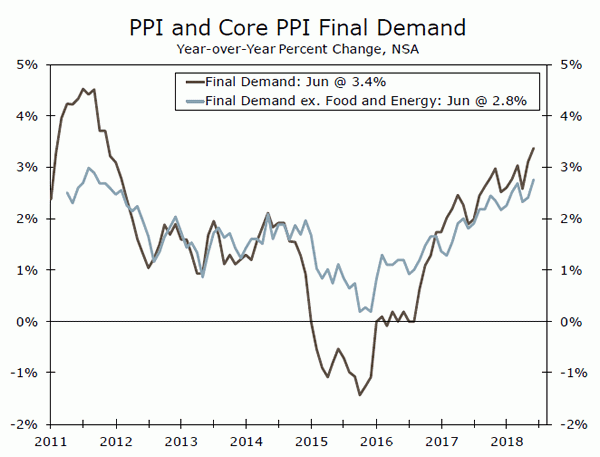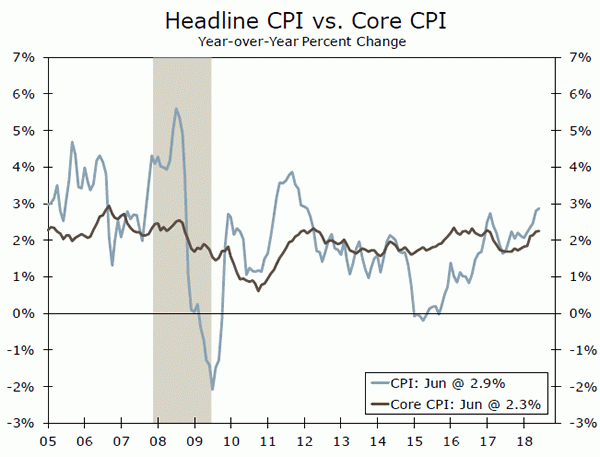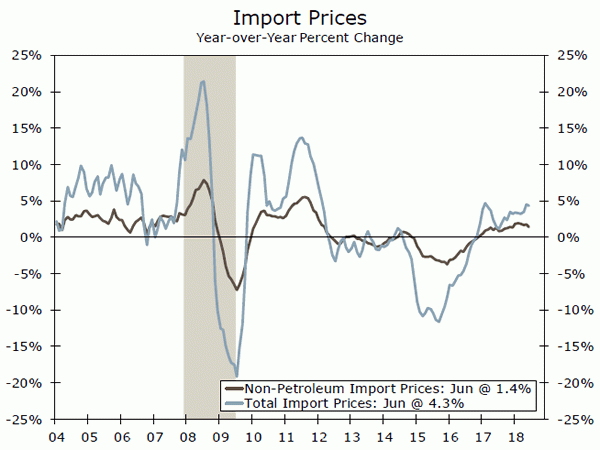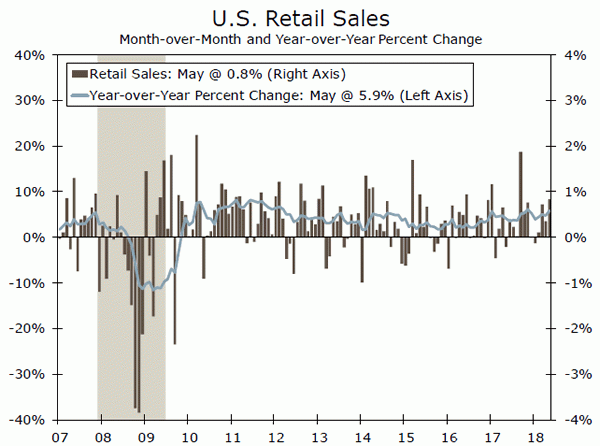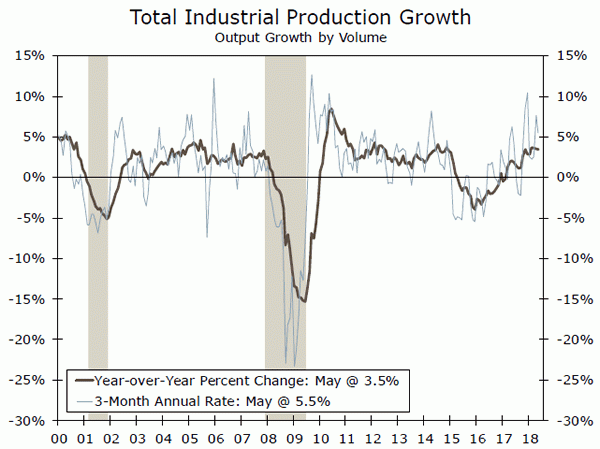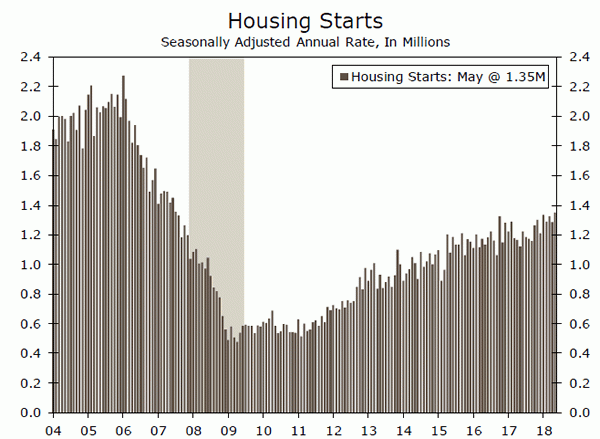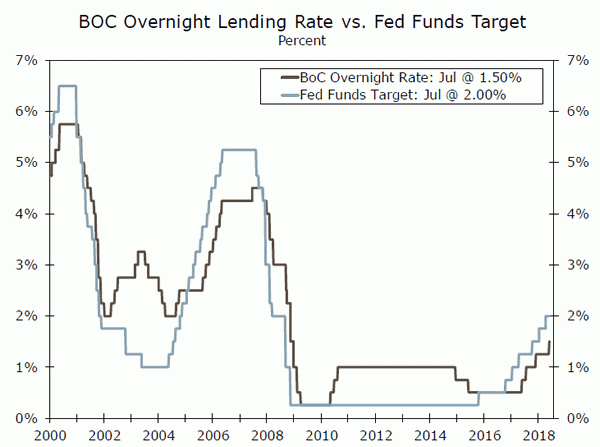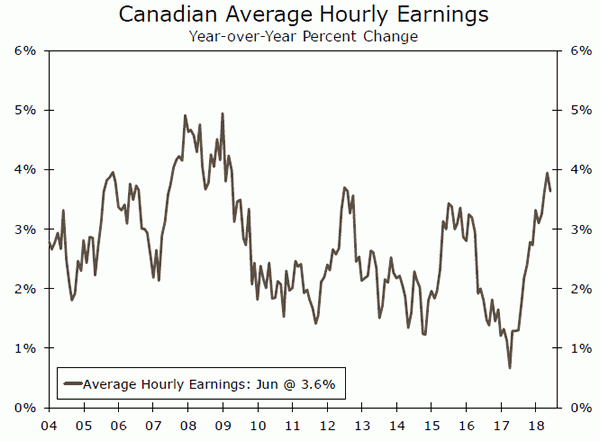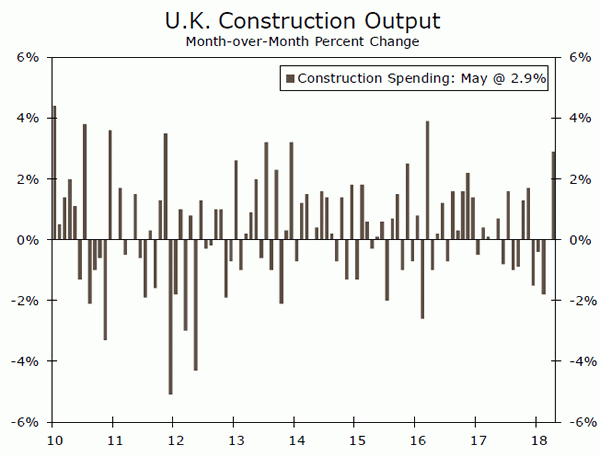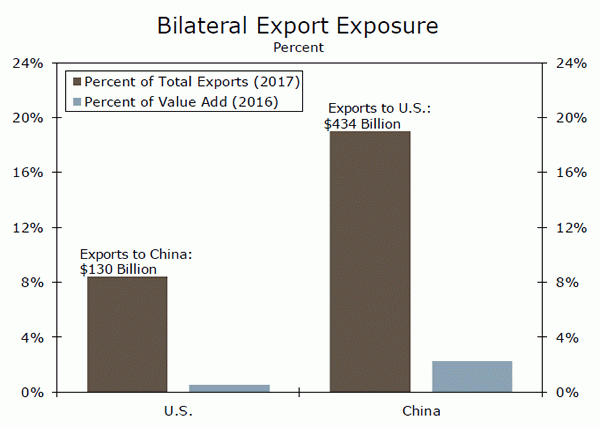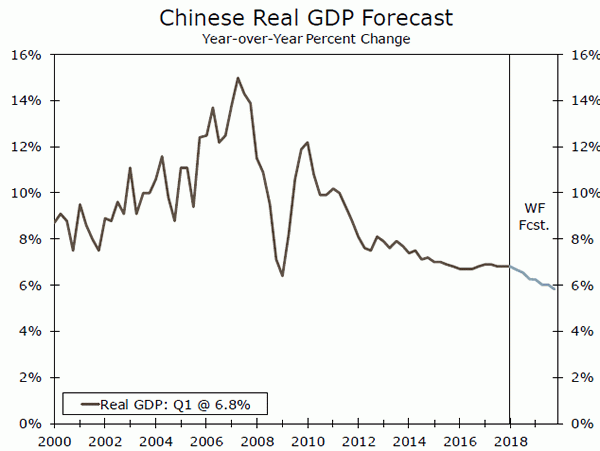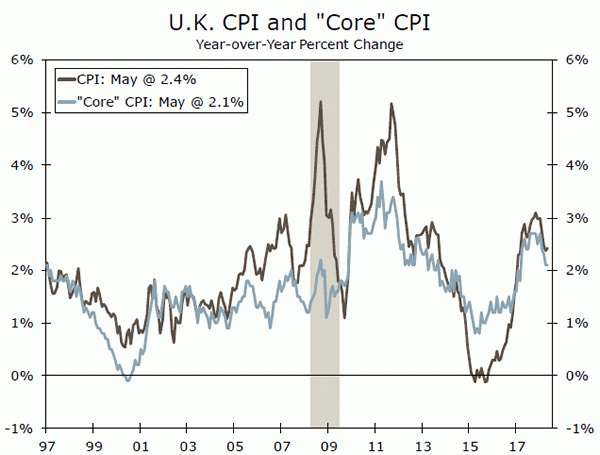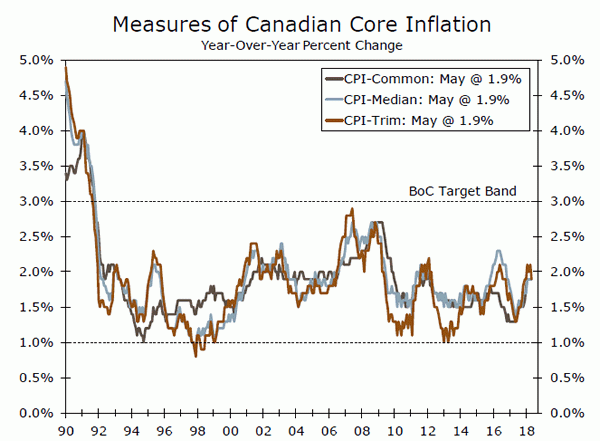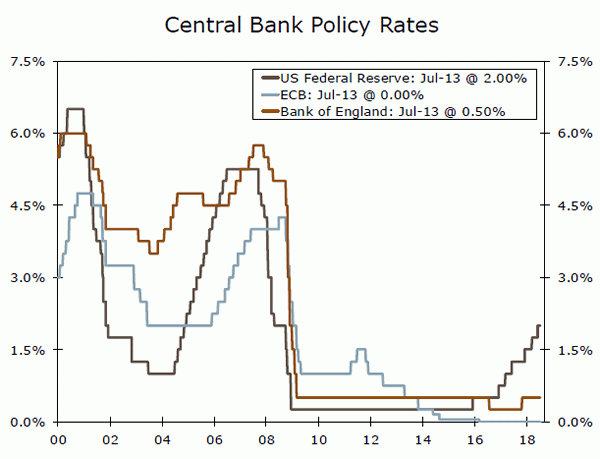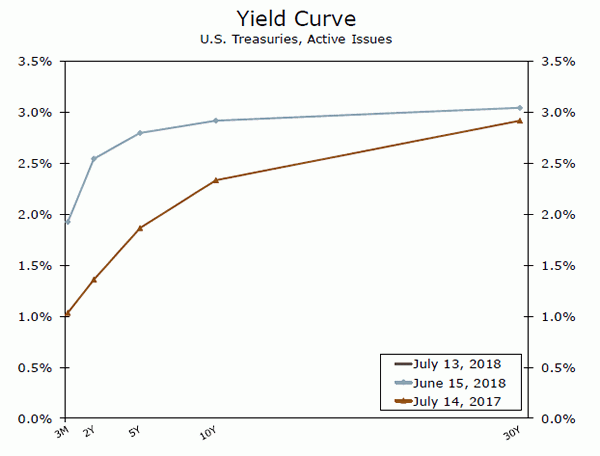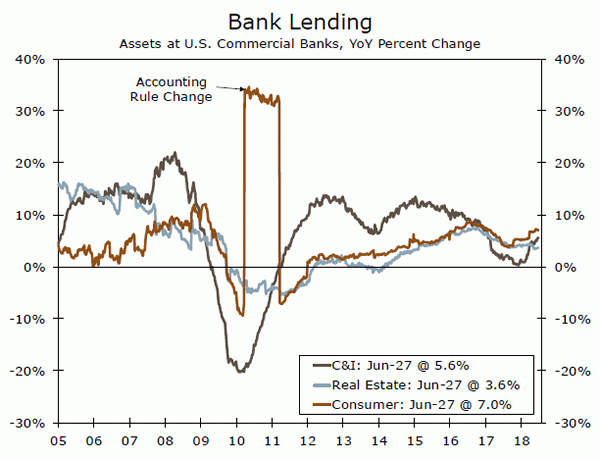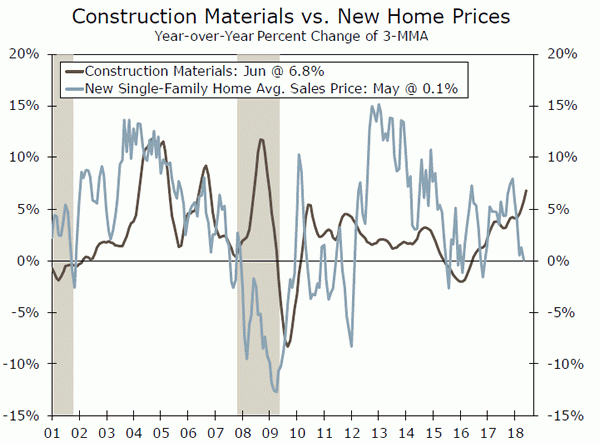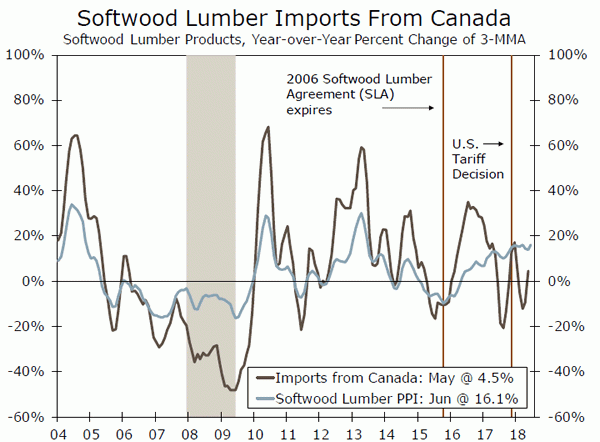U.S. Review
Price Pressures Still Building
- In the midst of tighter labor markets and backlogged supply chains, inflation continued its upward climb in June. Tariff implementation adds upside risk to inflation.
- Producer prices for final demand rose 0.3 percent last month, pushing the year-over-year rate up to 3.4 percent. Similarly, the CPI came in at 2.9 percent on a year-over-year basis in June, marking the strongest pace in over six years.
- After what was otherwise a strong week for inflation data, import prices declined 0.4 percent in June.
Price Pressures Still Building
In the midst of tighter labor markets and backlogged supply chains, inflation continued its upward climb in June. U.S. producers are feeling the burden of tighter supply chains through rising input costs, which suggests added pressure on businesses to eventually pass some of that pricing burden onto consumers.
Tariff implementation adds upside risk to inflation. Steel and aluminum tariffs were extended to the European Union, Mexico and Canada on June 1. Manufacturers that transform, or use, metals into intermediate or end products may start to see production costs rise, as Canada is the largest, and Mexico is the third-largest, source of imports for both products (chart on first page). We have begun to see slight effects of tariffs in producer prices, and have potential to see tariffs push consumer prices higher later this year.
Producer prices for final demand rose 0.3 percent last month, pushing the year-over-year rate up to 3.4 percent, a fresh six-year high (top chart). The gain in producer prices for June suggests underlying price pressures are still building. Higher costs of fuel have caused a rise in transport costs, while the rise in service input prices is yet another indication that the tight labor market is adding pressure to prices. While higher energy prices have led the pickup in producer prices, non-energy materials for manufacturing and construction are up 6.5 percent since last June–steel and aluminum tariffs are likely contributing to this upward push in input costs.
A similar story of rising inflation followed for the consumer. The CPI came in at 2.9 percent on a year-over-year basis in June, marking the strongest pace in over six years (middle chart). The cost of food, shelter and gas have all seen steady gains over the past year. Energy goods, which represent about five percent of the index, led the strength in headline CPI. However, declining costs for electricity and utility gasoline over the past few months suggest this fuel-driven trend may ease in coming months. Core inflation has signaled firming in the underlying trend in inflation has firmed. The core CPI came in at 2.3 percent in June, further support that inflation is at the Fed’s target, likely keeping it on track to raise rates twice more this year.
We expect to see core CPI remain near its current rate through the second half of the year. Minimal slack in the economy points to price pressures intensifying. Broadening tariffs, including the possibility of consumer goods getting directly hit, create some upside risk to our inflation forecast of 2.3 percent in Q3.
After what was otherwise a strong week for inflation data, import prices declined 0.4 percent in June. So far this year, import price inflation has been subdued due to a stronger dollar and softening in global growth. All major categories of imports posted price declines in the month. It is important to note that tariffs are not included in the import price index, since they are added on later. However, the recent flattening in the underlying pace of import price growth should help ease the final cost burden to purchasers of imports when tariffs are applied.
U.S. Outlook
Retail Sales • Monday
Retail sales came in stronger than expected in May. Sales jumped 0.8 percent, while prior month sales in April were also revised up to a 0.4 percent gain. Gasoline station sales grew 2.0 percent, in part due to rising gas prices. However, even excluding sales at gasoline stations, sales grew at a strong 0.7 percent clip. The strongest sectors in May were miscellaneous stores and building material and garden equipment and supplies dealers, which increased 2.7 and 2.4 percent, respectively. Furniture and home furnishing stores and sporting goods, hobby, and book stores sales declined for the month.
Control group sales, which are used in the calculation of GDP, increased 0.5 percent, while growth in April’s index was also revised up from 0.4 percent to 0.6 percent. The strength of May’s retail sales, as well as the upward revisions to prior month sales, are consistent with a second quarter rebound in personal consumption expenditures following a relatively weak start to the year.
Previous: 0.8% (Month-over-Month) Wells Fargo: 0.5% Consensus: 0.6%
Industrial Production • Tuesday
Industrial production dropped 0.1 percent in May, with much of the decline due to a 0.7 percent fall in manufacturing output. Some of the weakness in manufacturing can be attributed to disruptions in the auto sector caused by a major fire at a parts supplier. However, nondurable manufacturing also dropped with declines in a majority of the sub-sectors. Outside of manufacturing, mining and utilities production was stronger in May. Utilities continued to expand and registered a 1.1 percent gain. Higher energy and commodity prices also continued to boost mining activity, which increased 1.8 percent.
Soft measures such as the ISM index, continue to paint a much rosier picture of the factory sector than what is currently being reflected in the hard data. Despite May’s overall lackluster report, we continue to expect industrial activity to pick up to a level that is more consistent with the sentiment being expressed through the various manufacturing surveys.
Previous: -0.1% (Month-over-Month) Wells Fargo: 0.5% Consensus: 0.5%
Housing Starts • Wednesday
Housing starts increased more than expected in May, rising 5.0 percent to a 1.35 million-unit pace. Single family starts increased 3.9 percent, while multifamily starts grew 7.5 percent. The bulk of new housing starts occurred in the Midwest, which jumped 62.2 percent in May. Meanwhile, starts fell 15 percent in the Northeast. The South, which typically accounts for roughly half of all new starts, declined 0.9 percent. Starts also fell for the second consecutive month in the West, falling 4.1 percent in May. Construction in the West remains exceptionally strong, however, and is up 22.4 percent year-to-date.
Residential construction remains on solid ground and is up 8.9 percent on a year-to-date basis. However, most of May’s gain was in the Midwest, and building permits fell 1.2 percent for the month. Tightening supply constraints may be causing delays for smaller homebuilders. We expect housing starts to not be as strong in June.
Previous: 1,350K Wells Fargo: 1,314K Consensus: 1,322K
Global Review
The BoC Tightens Amid Escalating Trade Tensions
- In a week dominated by trade war headlines, the Bank of Canada (BoC) elected to hike its main policy rate 25 basis points for the fourth time in the past year
- In the United Kingdom, data from the production side of the economy broadly signaled a rebound in economic growth in Q2, which should allow the Bank of England (BoE) to raise its main policy rate at its August meeting.
- The big news this week was the United States’ decision to initiate a process that could lead to another $200 billion in tariffs on imports from China.
The BoC Tightens Amid Escalating Trade Tensions
In a week dominated by trade war headlines, the Bank of Canada (BoC) elected to hike its main policy rate 25 basis points for the fourth time in the past year (see chart on front page). Core measures of inflation are near the middle of the BoC’s target range, and average hourly earnings growth in May was the highest since 2009 (top chart). Although economic growth has downshifted a bit in recent quarters, the underlying trend at present is enough to gradually reduce any remaining spare capacity in the economy.
Trade uncertainty is the most immediate risk to an otherwise solid outlook for the Canadian economy. The BoC noted in its press release that the effect of trade uncertainty on Canadian investment and exports is likely to be larger than they originally estimated, and that “the possibility of more trade protectionism is the most important threat to global prospects.” Canada sent 76 percent of its goods exports to the United States in 2017, and exports make up almost a third of Canadian GDP. Thus, escalating trade tensions with Canada’s southern neighbor could have a significant impact on growth. Given the fairly strong fundamentals currently in place, we expect the BoC to hike once more in 2018, but the risks are tilted to the downside in our view.
In the United Kingdom, data from the production side of the economy broadly signaled a rebound in economic growth in Q2. Manufacturing output rose 0.4 percent in May, the first positive month-over-month reading since December, and monthly construction output growth rose at the fastest pace since April 2016 (middle chart). A sustained pick-up in construction output in particular would be a welcome sign, as Brexit-related uncertainty likely weighs on this fixed investment sector more than most. With economic growth rebounding and inflation continuing to recede, we look for the Bank of England (BoE) to hike rates at its August meeting. Growth is likely to remain fairly modest, however, and with Brexit lurking in the background, the BoE is likely to undertake any additional tightening at a gradual pace.
The big news this week was the United States’ decision to initiate a process that could lead to another $200 billion in tariffs on imports from China. The trade saga has been ongoing for much of the Trump presidency, and the China-U.S. developments initially began with goods-specific tariffs that impacted China along other countries, such as tariffs on washing machines, solar panels and steel and aluminum imports. In June, the U.S. announced and eventually implemented a country-specific, 25 percent tariff on about $34 billion in Chinese goods, effective July 6. China retaliated in-kind, and tariffs on another $16 billion in Chinese goods are pending over the next few weeks.
It was against this backdrop that President Trump once again upped the ante, as the United States Trade Representative (USTR) proposed an additional 10 percent tariffs on products of China with an annual trade value of approximately $200 billion. Should the United States go through with this proposal, a potential effective date remains unknown, though public hearings for the proposal will occur from August 20-23, making September the earliest the tariffs could likely be imposed.
Global Outlook
China GDP • Monday
Real GDP in China grew 6.8 percent in Q1 year over year, matching the pace of growth seen in the prior two quarters. However, recent monthly indicators point to a likely slower pace of GDP growth registered in Q2. Retail sales rose just 8.5 percent in May year over year, the slowest pace of growth since 2003, and fixed investment spending grew a similarly slower 6.1 percent, reinforcing the continued downshift in capital-intensive production as the economy continues to move in line with its advanced counterparts.
The Chinese central bank also recently cut its required reserve ratio 50 bps, and this easing of monetary policy along with ongoing trade disputes caused the Chinese renminbi to depreciate markedly against the U.S. dollar in recent weeks. We look for the expansion in China to remain intact, albeit at a slower pace than the double-digit growth rates the economy enjoyed in previous years, and forecast real GDP growth of 6.7 percent in Q2.
Previous: 6.8% (Year-over-Year) Wells Fargo: 6.7% Consensus: 6.7%
United Kingdom CPI • Wednesday
Consumer price inflation has continued its return toward the Bank of England’s (BoE) 2 percent target in recent months after surpassing 3 percent in late 2017. As price pressures continue to recede and real income growth slowly returns, consumer spending should also pick up. We may be starting to see evidence of this shift, as retail sales beat consensus estimates and rose 1.3 percent in May month over month, while real wages should also continue their gradual upward trend.
After remaining on hold in May due to weaker-than-expected Q1 data, we look for the BoE to raise rates 25 bps at its August meeting. Although inflation has moved lower and Brexit negotiations remain a concern, the labor market remains tight, and consumer spending looks poised to rebound. These factors should support stronger GDP growth and gradual policy normalization in the coming quarters.
Previous: 2.4% (Year-over-Year) Wells Fargo: 2.5% Consensus: 2.6%
Canada CPI • Friday
Consumer prices have continued their steady upward trend in Canada, with the CPI rising 2.2 percent most recently in May, year over year. While inflation has been moving higher within the Bank of Canada’s (BoC) target band, real GDP downshifted in Q1, growing only 1.3 percent year over year after the breakneck 4 percent pace registered in Q1-2017. But, faster monthly GDP growth so far in Q2 should support GDP growth of more than 2 percent for the quarter.
On-target inflation and other signs that the Canadian economy is operating near full capacity led the BoC to raise its overnight lending rate 25 basis points this week. The Canadian dollar has fallen in the wake of ongoing trade disputes, and new tariffs on U.S. imports will also put upward pressure on prices. Although we acknowledge that trade uncertainties remain, we look for the BoC to hike rates once more this year amid a likely uptick in economic growth and continued upward trend in prices.
Previous: 2.2% (Year-over-Year) Wells Fargo: 2.5%
Point of View
Interest Rate Watch
Tariffs, Inflation and the Fed
Changes to U.S. trade policy are becoming more difficult for central bankers to shrug off as tensions escalate. Last week’s minutes from the June FOMC meeting showed “most participants noted that uncertainty and risks associated with trade policy had intensified.” That was before the Trump administration this week moved forward with plans to impose tariffs on an additional $200 billion of goods from China.
On the surface, tariffs on a widening array of goods stand to be inflationary for the United States, which would suggest the need for a tighter policy stance by the Fed now that inflation has returned to the FOMC’s target. However, the imposition of tariffs would be a one-time level shift in prices. Such one-time changes can lead to a meaningful movement in the price level, but do not result in a sustainably higher rate of inflation that leads the Fed to adjust its policy path.
The temporary effect on inflation will, in all likelihood, lead the FOMC to look through any increase associated with the initial rise in tariffs. The need to look through a tariffrelated bump in inflation would be further fueled by downside risks to the outlook as investment gets shelved and real purchasing power diminishes. As trade concerns have grown, fewer Fed officials believe risks to economic growth are tilted to the downside.
Not So Clear Cut Late Cycle
Looking through a tariff bump in inflation, however, is not likely to be straightforward. Inflation is already poised to rise as capacity has become increasingly strained at this late stage of the cycle. Therefore it could be difficult to disentangle the effects of tariffs from longer-lasting forces.
One way in which tariffs could still end up contributing to such longer-term inflation dynamics is via inflation expectations. Seeing prices pick up may lead consumers and businesses to think there is more inflation to come and influence their willingness to push for higher wages and raise prices. Here too, such willingness may stem from the tight state of the economy, although when it comes to inflation expectations, the distinction is less likely to matter for the Fed.
Credit Market Insights
Government Debt & the Yield Curve
The government debt service ratio in advanced economies’ has remained relatively constant since the Great Recession. This is largely due to the low interest rate environment. While low interest rates are typical during a recovery, to encourage private spending and investment, they also decrease the government’s cost of stimulating economic activity through debt financing.
Between Q4-2009 and Q4-2012, the aggregate government debt-to-GDP ratio for advanced economies rose 9 percent year over year. However, advanced economies are still financing economic growth by taking on debt, with the government debtto- GDP ratio growing more than 4 percent between Q4-2013 and Q4-2017.
Earlier this week, we released a report examining the yield curve, the implications of its potential inversion and causes behind its flattening. We found a preference for longer-term Treasuries as a possible cause of flattening. One way for countries to finance rising debt is to issue more debt. A study by the OECD* found that countries are focusing issuance on long-term instruments. This extra pressure on longterm yields could also contribute to the flattening of the yield curve.
Looking forward, advanced countries’ debtto- GDP ratios remain an area to watch as interest rates continue their upward trend amid a flatter yield curve.
Topic of the Week
Softwood Lumber and Home Prices
Construction materials prices are up more than 8 percent over the past year, the highest growth rate since late 2008 (top chart). A major factor driving this trend is higher softwood lumber prices, which have jumped since the United States announced final duties of about 20 percent on Canadian softwood lumber imports in November. According to the National Association of Homebuilders, framing and trusses account for the largest share of construction costs for a single-family home, at 16.6 percent. Therefore, rising lumber prices can have a marked effect on the cost of building new homes across the United States.
From October to June, wholesale prices for softwood lumber have risen 17 percent (bottom chart). Lumber prices were already rising before tariffs were imposed, due to timber losses from mountain pine beetle, transportation bottlenecks and rising demand from the housing market. However, tariffs also play an important role because of Canada’s huge weight in the U.S. lumber market. Canada supplies 90-plus percent of softwood lumber imports to the United States and nearly 30 percent of American lumber consumption. Softwood lumber imports from Canada declined in the first quarter but are up slightly year-to-date; U.S. homebuilders and other purchasers have few alternatives, and have had to swallow price increases.
New homes account for only about 10 percent of U.S. home sales, limiting the impact of construction costs on overall housing prices. However, persistently low inventories of existing homes in the current cycle mean that new homes are an important source of marginal supply, especially in rapidly-growing markets. New home inventory was up 11 percent year-over-year in May compared to a decline of 5.2 percent in existing home inventory. High construction costs and labor shortages, however, are making it harder for builders to provide new supply, particularly at the low end of the market where margins are thinner. Rising interest rates and limited supply of entry-level homes are increasingly standing in the way of first-time homebuyers.




